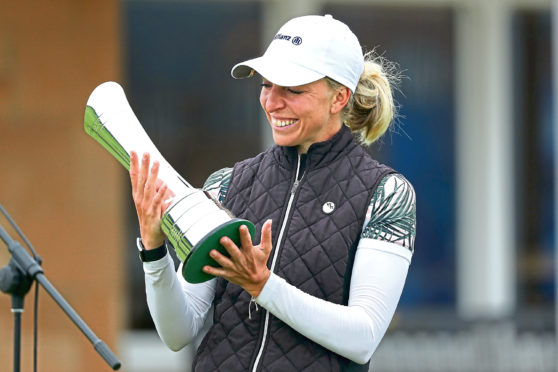What to make of Sophia Popov’s victory in the AIG Women’s Open, her first serious win, much less her first major win?
What it mostly confirms is that golf, like no other sport, has the capacity to see the most outlandish dreams fulfilled.
We’ve all seen the sports movies (and very few of them are any good) where the coach/manager nods to the untried young hopeful and mutters “you’re on”, and the kid plays a blinder, the team wins the championship and the glory music rises as he/she becomes a legend overnight.
It happens in the movies because it never happens in real life team sports. Nobody takes a chance on anyone – those who reach the elite end in football, rugby, cricket or the American sports have been poked and prodded, analysed and coached up to their eyeballs. If a “star is born”, it’s always – always – known potential fulfilled.
Somebody on Twitter tried to make this claim for Sophia in the light of her Royal Troon victory. This wasn’t out of nowhere, Sophia was a former World No 5 in her amateur days. This was potential being fulfilled.
Well, excuse me, and this isn’t to decry Sophia and her deserved achievement one iota, but she had eight years of basically nothing as a professional.
Illness – an undiagnosed dose of lyme disease – played a part in that, but eight years is enough time if potential to be fulfilled in most minds.
Sophia had faith in her own ability, and credit to her that she did. But who else throught she was just about to blossom without warning?
There are thousands of players out there on the mini and satellite tours or just trawling the internet for places to play who have faith in their own ability. There are hundreds of them who were class amateurs who just haven’t hit their hats when they’ve turned pro.
But the crucial difference in golf to other sports is that every single one of them is maybe just a couple of tournaments away from what Sophia has done.
They’re dreamers, of course they are. The odds are laughable that it can happen. But it DOES happen in golf, and reasonably regularly.
I have to admit, as an unreconstructed cynic, I often find golf’s many dreamers at times to be a little frustrating.
“It’s close” is the standard cliche of most struggling players, and there’s always Q School, the El Dorado of every dreamer, where (in Europe at least) you pay £1800 for the right to play a gruelling 14 rounds to try and be in the top 30 among around 2500 and get a (reduced status) card for the big show.
You want to shake them by the shoulders and tell them to face reality. But you don’t, because of people like Ben Curtis, or Todd Hamilton, and Shaun Micheel or Rich Beem; or even better, people like Paul Lawrie, Ian Poulter and Robert Rock, who seized their big chance and built outstanding careers out of it.
And now Sophia Popov. She nearly quit the game a year ago, she wasn’t even in the Women’s Open until she got a rare start on the LPGA in Toledo at the start of August and finished 10th.
Sophia will now be the poster girl for the dreamers – if she can do it, so can they. Of course, it’s doesn’t happen very often, but it does happen enough to fuel their determination to press on.
I used to shake my head at the dreamers, but perhaps the softening old age has brought me round to their way of thinking.
It’s one of the glories of golf that this Cinderella story can and does happen. More power to the dreamers; there’s an awful lot of them out there, but one of them is the next Sophia Popov.
The mania for green speeds
The Women’s Open was completed without a delay, despite winds gusting to 40 mph, as well as heavy rain. Furthermore, to the credit of all involved, the pace of play was more than decent, even in those weather conditions.
We lost a full day at St Andrews in the 2015 Men’s Open through winds of roughly the same speed. Thankfully, the R&A seemed to have learned a valuable lesson from that debacle.
The greens at Troon last week were running at an average of 9.5 on the stimpmeter, but at 8.1 in the gales on Thursday and Friday. By comparison, the greens at the Masters habitually run at 12.5 on the stimp.
Of course, that’s fine – still very quick, mind you – for a usually balmy April in Augusta. But for some reason that kind of speed became de-riguer for the whole game, as if everywhere had the weather of Florida, San Diego and Arizona.
2015 proved, finally, that in links golf slower greens are acceptable, even desirable. It’s part of the different challenge of our game, and often necessary to ensure play can continue.
The modern mania for ludicrous green speeds is partly a macho thing, partly due to modern elite golf’s lust for having everything the same, every week – driven by entitled players who think varying conditions are “unfair”.
Slower greens make golf easier for most, speed up play, and are less intrusive on the environment. It’s an easy way to make a difference in those problem areas for golf.
